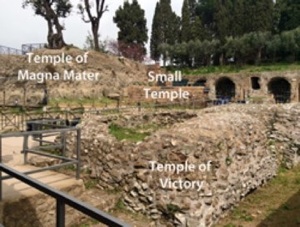
Temple of Victoria Virgo (193 BC)
Livy recorded that, in 193 BC:
-
“... a shrine to Victoria Virgo near the temple of Victory was dedicated by M. Porcius Cato,[Cato the Elder], two years after he had vowed it”, (‘History of Rome’, 35: 9: 3-6).
Thus, it seems that Cato:
-
✴vowed a shrine to Victoria Virgo in 194 BC, when he was proconsul in Spain; and
-
✴dedicated it in the following year, when (as far as we know) he held no public office.
Its dies natalis (1st August) is recorded in two of the surviving calendar-based fasti:
-
✴ fasti Antiates Maiores: Spei Victor(is) II (To Spes; to the two Victories)
-
✴fasti Praenestini: Victoriae Victoriae / virgini in Palatio Spei in/ foro Holitorio [i.e., to:
-
•Victoria, (probably the temple of Victory on the Palatine - see below);
-
•Victoria Virgo, also on the Palatine; and
-
•Spes, in the Forum Holitorium).
None of our surviving sources indicates the circumstances that prompted Cato to build the new shrine to Virgo Victoria, although they may be deduced from the following:
-
✴The fasti Triumphales record that he was awarded a triumph in 194 BC for a victory that he had won in Spain as proconsul.
-
✴Plutarch described the campaigns that he undertook there:
-
“... while he was subduing some of the tribes and winning over others by diplomacy, a great host of barbarians fell upon him and threatened to drive him ignominiously out of the province. He therefore [paid] the neighbouring Celtiberians to become his allies. ... [In the battle that followed], he was completely victorious, and the rest of his campaign was a brilliant success. ... Cato himself says that he took more cities than he spent days in Spain ... His soldiers got large booty in this campaign, and he gave each one of them a pound of silver besides, saying that it was better to have many Romans go home with silver in their pockets, than to have a only a few [go home] with gold. But, he says that ... no part of the booty fell to him, except what he ate and drank. ... [When his replacement arrived from Rome], he took five cohorts of men-at‑arms and 500 horsemen as escort on his way home: on this march, he subdued the tribe of the Lacetanians and put to death 600 deserters whom they delivered up to him. .... [On his return to Rome, he] celebrated a triumph”, (‘Life of Cato the Elder’, 10-11).
-
✴Livy recorded that, in 194 BC:
-
“... M. Porcius Cato triumphed over Spain. In his triumph, he carried 25,000 pounds of silver bullion, 123,0000 silver denarii, 540,000 silver coins of Osca, and 1,400 pounds of gold. From the booty, he gave 270 asses to each of his soldiers, and three times that amount to each trooper”, (‘History of Rome’, 34: 46: 2-3).
None of these accounts record that Cato had vowed to build the shrine during a battle. However, if Plutarch is correct in claiming that he took nothing for himself during his campaign in Spain, we might reasonably assume that the booty that was not dispersed to the soldiers passed to the public purse: Penelope Davies (referenced below, 2017, at p. 120) suggested that Cato:
-
“... probably earmarked some [of it] to finance his [shrine] to Victoria Virgo ...”
It is certainly possible that the Senate devoted a small part of this booty to the building of the shrine, and that, despite the fact that Cato held no public office in 193 BC, he was asked to dedicate it as a mark of honour. As I discuss below, this procedure would have been consistent with other circumstantial evidence that suggests the existence of a senatorial policy to rein in the growing ambition and ostentation of other members of Rome’s military élite.
As noted above, the surviving fasti locate Cato’s shrine on the Palatine and record that shared its dies natalis (1st August) with another temple of Victory: it is usually (and reasonably) assumed that this was the imposing temple of Victoria that L. Postumius Megellus had dedicated in 294 BC (as described in my page on the Temples Vowed in the Second Samnite War). Penelope Davies (referenced below, 2017, at p. 92) argued that Cato’s shrine:
-
“.... may have sat on unusually small foundations between the Temples of Victoria and Magna Mater [which would have been still in construction in 193 BC - see below].”
She observed that its:
-
“... modest scale, [which was] possibly exaggerated by its position between two substantial temples, fits the mood of austerity that Cato advocated after the Second Punic War. If ... Megellus’ temple of Victoria ... had initiated a discourse on monumentality in sacred architecture, [then the shrine] of Victoria Virgo voiced an antithetical retort.”
Read more:
Davies P., “Architecture Politics in Republican Rome”, (2017) Cambridge
Return to Rome in the Early Republic (509 - 241 BC)



